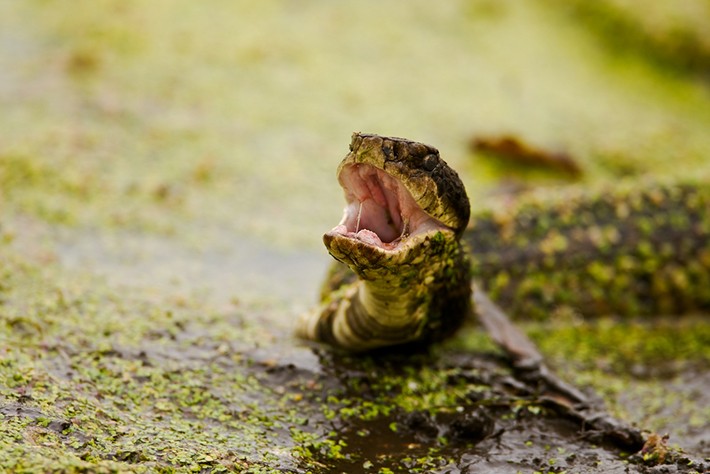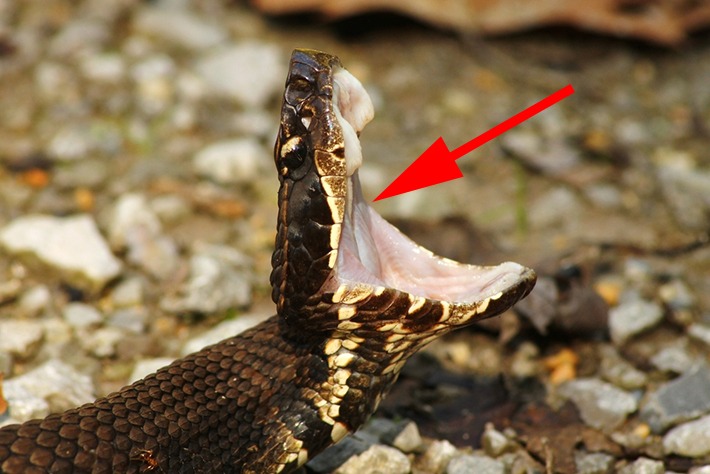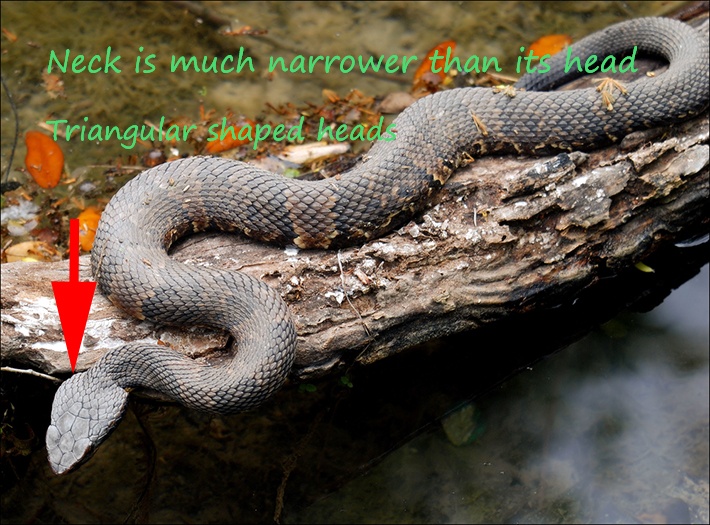I’ve been hiking and trekking around the states for a really long time now, and every now and then I encounter lethal wild animals, the most dangerous of which are snakes.
I know plenty of wild animals can be as lethal as snakes, but the main reason why I think snakes are the most dangerous is because they can creep up on you and give you a quick and deadly blow.
More...
During my travels, I have frequently encountered a certain water snake that started to pique my curiosity.
After doing a bit of research, I found out that what I usually encountered was a water moccasin. Back then I thought it was just a harmless water snake, but it turned out to be one of the most poisonous snakes in the U.S.
To help all my readers out there, I decided to make this short guide on how to identify a water moccasin. Knowing about water moccasins is quite easy and very useful for future outdoor trips.
Take a look at what I learned about water moccasins below to save yourself or your loved ones from a dangerous snake bite.
What Is A Water Moccasin
First thing’s first, what exactly is a water moccasin? Though snakes may look very similar, there are actually 3,000 species of snake wriggling around the world, 375 of which are venomous. The water moccasin, also known as the cottonmouth viper, happens to be one of the most venomous snakes out of the 3,000 species of snakes today.
What’s dangerous about water moccasins is the fact that they can easily be mistaken for non-venomous water snakes.
This is why it’s important for average outdoor explorers to know how to identify a water moccasin.

Other things you should know about water moccasins is that they are semi-aquatic snakes that like to spend time on both land and water.
You will often find them all throughout Florida extending northwards to Virginia and to the west towards, Missouri, Oklahoma, Texas, and Illinois.
Now even though water moccasins are venomous, they’re still pretty passive snakes. Only in rare occasions do they bite humans.
If you ever find yourself in a water moccasin encounter, just walk away from the snake to avoid provoking it.
How To Identify A Water Moccasin
Like I said earlier, identifying water moccasins is very easy if you know what to look for. Here are a couple of telltale signs that you’re face to face with a water moccasin.
1. Water Moccasins have White-colored Mouths

When a water moccasin gets threatened, it opens its mouth as a form of self-defense to scare away its predators.
If you see that the insides of its mouth are all white, you may be staring at a water moccasin. That’s why they’re called cottonmouths after all.
When trying to identify a water moccasin, do not attempt to touch the snake just to get its mouth open. Doing so will only put you at greater risk of a bite.
2. Color and Patterns
This may be more difficult to identify if you’re no snake expert. It may not even be useful to you if you are colorblind.
But still, keep in mind that water moccasins come in a dark brown or almost black color.
Young water moccasins can have vivid hourglass patterns spread all over their body. As these snakes age, their color gets darker and the patterns turn less vivid.
Do take note that water moccasins may have a similar pattern to copperhead snakes, another venomous snake you’d want to avoid.
The main difference is copperhead snakes retain vividly shapes patterns as they get old and they tend to have a light brown color as opposed to the dark brown shades that are present in water moccasin scales.
3. Water Moccasins have Dark Eye Bands
If you take a look at a water moccasin’s head, you will notice that it has dark bands where its eyes are. It sort of looks like it’s wearing a mask.
Sometimes the dark bands can go completely over and past their eyes starting from the tip of their nose. The dark bands can also start from the back of their eyes going towards the back of their heads.
4. Water Moccasins Head’s are Broader than Their Necks.

Unlike harmless water snakes whose necks are wider than their heads, a water moccasin’s head is usually larger and more blocky than their whole body.
You will instantly notice how the water moccasin’s neck is much narrower than its head. This is probably the easiest way to identify a water moccasin in the wild.
Also remember that water moccasins have triangular shaped heads, sort of like the triangle part of a windsor tie knot.
5. Water Moccasins can usually be Found at Certain Locations
Knowing about a water moccasins natural habitat is another sure way to determine whether you are facing a water moccasin, a non-venomous water snake, or a dangerous copperhead snake.
Water moccasins are usually found in swamps, ponds, and pretty much anywhere near bodies of water. They prefer moist and wet areas as opposed to dry forested areas.
What Happens When You Get Bitten By A Water Moccasin
Since water moccasins are part of the pit viper family, you can expect to feel a surging amount of pain once bitten by it.
A water moccasin bite can aren’t really lethal, but it can ultimately lead to excruciating pain and tissue damage if not treated immediately.
As an effect, the venom will attach itself to your red blood cells and will cause blood clots all over your body starting from the area where you were bitten. If left untreated, your body will gain hemorrhages and swelling.
You may also feel lack of breathing as the venom spreads throughout your body and dissolves your muscle tissue.
Discover more:
What To Do If You’re Bitten By A Water Moccasin
The best thing to do once you or someone you know is bitten by a water moccasin is to call 911 or go to the nearest hospital.
Do not attempt to cut the snake bite and suck the poison out and refrain from using a tourniquet or anything else to isolate the blood in the bitten area.
Instead, simply clean the bite wound with soap and water and then try to get medical help immediately.
A Quick Recap
Well, that’s all there is to it.
Remember, the five signs you have to keep in mind to identify a water moccasin is a white-colored mouth, a near black or dark brown color along with a blurry hourglass pattern, dark bands around its eyes, a triangular shaped head that’s wider than it’s neck, and the location where you encountered it.
Also, keep in mind to stay away from water moccasins to avoid provoking it into biting you.
If all else fails and you end up getting bitten by a water moccasin, simply wash your wound with some water then soap and try to get to the nearest medical center as soon as possible.
There you have it! A complete guide on how to identify a water moccasin. If you want to learn about more outdoor tips, feel free to look around my blog.
You will learn all sorts of things like which stuff to get for a hike, how to act when encountering animals in the wild, and so much more.
Don’t forget to show your love too by sharing this article with your friends and family. Until next time, safe travels!

Melanie, you Melanie, you rock! This is my first encounter with a cotton Mouth. And I thought it was dead. I was pulling garbage up along my Fenceline when I found it. My dogs were very interested in it and thankfully there was a fence between me and the dogs and our friend. But I wasn’t sure what kind of snake it was so I photographed it several times and came in and started looking. Yours was the clearest website I found. Thank you! And I appreciate especially, that you talk to us without condescending but knowing that we were complete dummies.
I recently moved to a house on a lake. While fishing from the bank I looked down a saw a large, black snake swim by….just a few inches away. It ignored me and my dog and simply swam on.
In the days since, I’ve seen several more and each time they simply swim by. I’d consider their behavior benign and non-threatening. Unlike my neighbor, I do not see the need to kill these snakes, even if they are water moccasins (I do not think they are)
My question is how we classify a snake’s behaviour. If it was aggressive, would it have tried to strike?
They can be extremely aggressive ! I know this for sure. We were in a small boat at my Dad’s pond. We didn’t provoke it unless our just being in a small boat on the pond provoked it! It sort of came up out of the water swimming extremely aggressively towards us. The boat was very small. We were extremely frightened. So to say they are not aggressive unless provoked may not always be accurate. Maybe when I wet my pants as it aggressively swam towards us provoked him further. Maybe he took exception to having to jump into a boat that smelled like urin.?